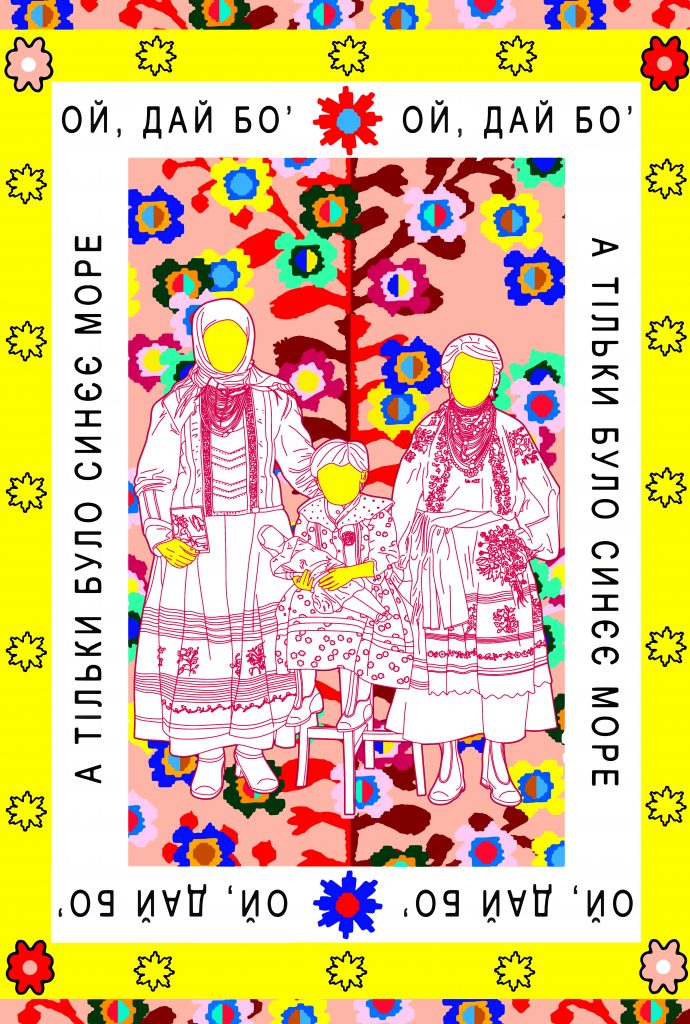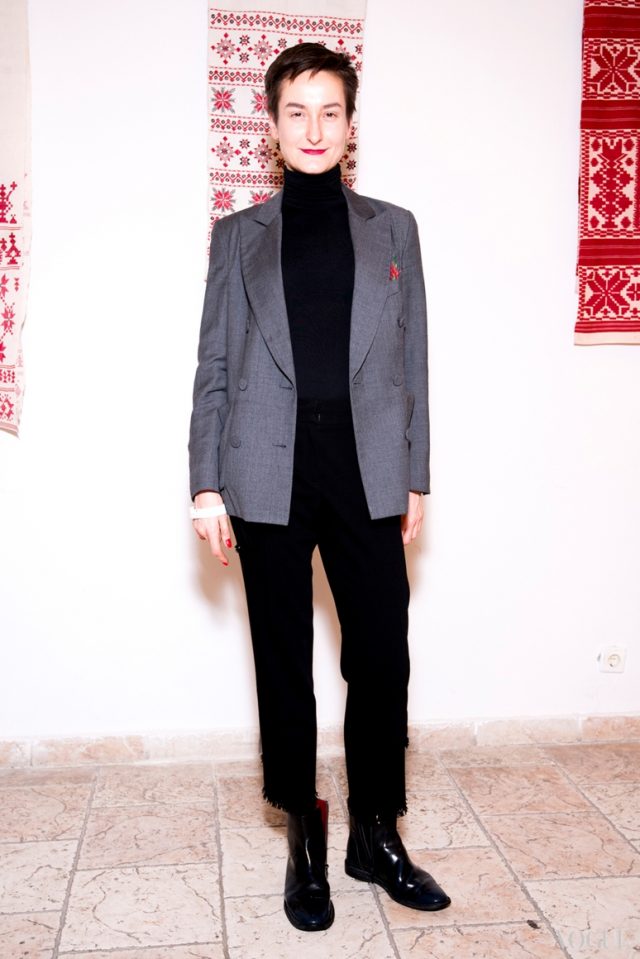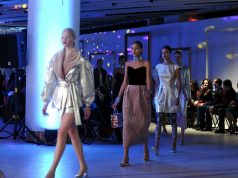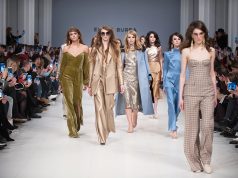Tetyana Solovey wears many hats. She’s the editor of Vogue Ukraine, a fashion writer and a part-time PR agent for the Ivan Honchar Museum of Ukrainian folk art.
Now Solovey is working on something new. Using the Big Idea platform, Solovey is collecting money for the Ivan Honchar museum’s holiday project. In the project, contemporary Ukrainian artist Ola Listunova has created 14 posters featuring drawings and words representing the ancient Ukrainian carol “O, how it was before the start of time”. They will be placed outside the museum to serve as a colorful background for Instagram photos in the runup to Orthodox Christmas.

The project aims to expand ideas about using museum space. The Honchar Museum has already launched an online animated video using Listunova’s drawings. Viewers can also customize the video with a personal greeting and send it to friends as an unusual Christmas card.
Solovey spoke with The Odessa Review’s fashion writer, Aliona Nagornaya, about Ukrainian culture, museum culture and her first experiences with crowdfunding.
The Odessa Review: Today, the Ivan Honchar Museum has the image of an institution that makes folk culture fashionable. In many respects, this is your achievement. Why did you do this?
Tetyana Solovey: Interest in Ukrainian culture and everything “Ukrainian” increased dramatically during and after the Euromaidan revolution because the question “What is Ukrainian identity?” suddenly became relevant. This identity is broader and much more than just folk culture. However, at that time, traditional culture was an absolutely obvious symbol and the most accessible answer to this question for a huge number of people. When you make a fashion magazine during a military conflict, the inevitable question arises: What is the point of the work that you love and do best? What else can I do now? On the advice of [Ukrainian fashion designer] Lilia Poustovit, I went to the Ivan Honchar Museum. That’s where you can learn a lot about Ukrainian folk culture. Today, the collection of the Honchar Museum has more than 30 thousand works of folk art, traditional household fixtures and customary ceremonial items, antique books and archival materials, as well as paintings and sculpture works by [artist] Ivan Honchar. The director of the museum is [Ivan Honchar’s son] Peter Honchar, an artist who draws “naive” pictures and is able to work subtly with the museum exposition. In one hall, there are folk paintings of the poet Taras Shevchenko and a painting depicting the Cossack Mamay. Peter Ivanovich [Honchar] placed the two main male archetypes personifying Ukrainian folk culture in such a way that they are staring at each other through space. After acquainting myself with the museum and its director, I wrote several articles about the vyshyvanka [the traditional Ukrainian embroidered shirt-dress] and I realized that this was not enough. I decided to make the museum more visible in the media.

OR: But how did you manage to attract attention to the Ivan Honchar Museum within the Kyiv fashion media?
TS: I began to actively work with the museum. I literally became its PR agent. I was very interested in how to better connect the museum to what is happening internationally all over the world. I started to support its Instagram. Because I knew what formats are good for fashion media, we began to hold joint events that were covered in the press and online. Our first joint event took place during the Night of Museums. A poster for it was made by designer Dina Linnik. A screen in the museum broadcast fashion shoots by Julie Pelipas [Fashion Director of Vogue Ukraine] for Vogue. And the museum held the presentation of the art book “Grushka” by Ola Listunova and Mark Otogh. It also hosted a series of collages by Roman Mikhailov, the Kalita Celebration [a Ukrainian traditional youth holiday] and another Night of Museums. After ethnographic field trips inspired by the educational work of the museum, Vasilina Vrublevskaya shot an Eastern Street-Style in the village of Kosmach in Ukraine’s Hutsulshchina [i.e. the region home to the Carpathians Mountains’ Hutsul minority]. With the informational support of the Ivan Honchar Museum, Vogue Ukraine published a really strong and fantastically beautiful cover-story on Malanka [i.e. the Ukrainian traditional holiday marked on the night before the New Year, according to the old Julian calendar].
OR: Your project for the Honchar Museum on the Spilnokosht crowdfunding page of the Big Idea social innovation website is the next step to popularize the museum. What was the most difficult part of preparing and launching the project?
TS: This project on Spilnokosht turned out to be a reality check. It was interesting to learn to what degree people are ready to join together and support the museum’s next big idea monetarily. When the project started, I realized that, in order to raise money for it, I have to tell everyone personally what project I worked on and ask them to share it or make a monetary contribution. Suddenly you realize that you have to find a completely new, different language of communication. It was kind of like zeroing in. Working with public opinion was much harder than I could have ever imagined.

OR: Nevertheless, it’s already obvious that the project will happen. I’m sure you’ve already set yourself another goal, right?
TS: To a certain degree, I think that it would be nice if the Honchar Museum had a permanent circle of admirers and patrons who would help and support the museum. Museums that exist on private subsidies have great potential for development. There are more opportunities to reboot the collections, to redo the exposition, to invite curators and to arrange exhibitions that resonate with the modern consciousness. An excellent example is the Costume Institute at The Metropolitan Museum of Art in New York, which frequently holds blockbuster exhibitions like the one dedicated to the works of [legendary British fashion designer] Alexander McQueen. These exhibitions gather huge crowds of visitors and the museum stays open until midnight and works over the weekend. It’s really huge work telling people about the art in the museum and about the museum itself in a way that makes them go there expecting something miraculous. Thinking about all this, I inevitably find myself caught between enthusiasm and panic! The question is how to make the museum of folk culture popular.
OR: I think if you don’t create a — let’s say — fashionable halo around traditional culture, then it automatically mummifies, gets covered with a thick layer of dust and eventually becomes a dated museum piece…
TS: In general, yes. Traditional culture does not exist in its original form in our modern life. The very concept of tradition is associated with a certain way of life. When you live in a closed society, tradition is more important than innovation. Nowadays, society lives for innovation and novelty. Traditional culture does not fit into this new world. As a result, we moved it from everyday life and endowed it with a decorative function. Of course, you can buy painted pottery at the Kosovo market [located in the ancient city of Kosovo in Subcarpathian Ukraine], but you will use a plate that you bought in IKEA or in an antique shop because you like porcelain. You can wear a vyshyvanka as a festive outfit to show off. But it’s not something that can help you to live, that connects you to your roots and gives you strength and other things that they say about shirts in traditional culture.
The vyshyvanka was preserved throughout the past. And in this sense, it is interesting to look at it and seek some new, but related forms that resonate with the present day. Does manual sewing resonate? Yes! On the other hand, there is also machine sewing, and it looks very good. But if a person with the right impeccable taste draws attention to the technique of manual sewing, then it works.

That’s what Vita Kin — who first rebooted the vyshyvanka topic — did. “Vyshyvanka by Vita Kin” is based on an ethnic cultural product, but it’s completely modern and it fully meets the needs of modern women. If these women are asked to put on a vyshyvanka that is sold somewhere on the street, it will not be as comfortable and wearable as Vita’s. That’s what’s important and cool: to find your story in traditional culture and understand how to offer it to people.
The Honchar Museum collected the needed funds for its holiday project on Spilnokosht in the first week after launching crowdfunding. However, fundraising remains open until January 3, 2018. All donations made above the project’s fundraising goal will be used to support the Ivan Honchar Museum. You can support the museum’s holiday project here.




































